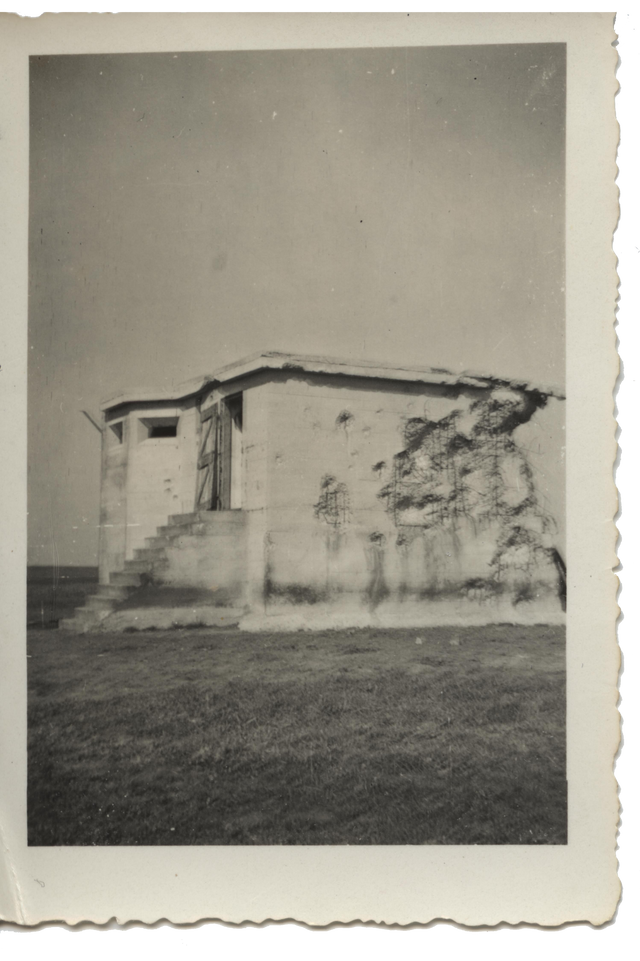Reading time: approx. 6 minutes
The observation tower in the marshlands of the Noarderleech is not strictly part of the Atlantic Wall. But the shrapnel-resistant tower for the Luftwaffe observers was a valuable link between the airport in Leeuwarden and the heavy fighting of the pilots above the Wadden area.
Leeuwarden's airport was built just outside the city between 1936-1937. Before the war, the airport was mainly used for domestic passenger flights and transporting goods. Even before the occupation, the Germans recognised the strategic location of this airport so near the coast. Immediately after invading the Netherlands, in the summer of 1940, they began to transform the airport into a military airfield: a Fliegerhorst. Every day more than 7,000 labourers worked to build runways, hangars, housing for personnel and storage. The Fliegerhorst played an important role in the heavy battles that took place above the Netherlands.
On 12 May 1940, farm residents behind the sea dike in Hallum were confronted with the first air battle above the Netherlands. In the early afternoon of that day, a German fighter plane, a Messerschmitt Bf 109, made an emergency landing on the Noarderleech. The pilot, who had been shot by anti-aircraft artillery above the Afsluitdijk, stepped out of his plane unscathed. He was transported to the airport in Leeuwarden. Two days later the Netherlands surrendered.
During the war, 5 allied and 6 German planes crashed near Noarderleech. Most of the allied and German crew members did not survive. There are 3 war graves in the public cemetery in Hallum. Some bodies washed ashore elsewhere, such as Harlingen, where they are also buried in the public cemetery. The bodies of crew members shot down somewhere else above the Wadden area washed ashore regularly during the war.
Sometimes the crew were able to eject from the aircraft in time, such as with the Short Stirling, a bomber carrying firebombs, that was on its way to Emden. It was shot by a Messerschmitt above Schiermonnikoog on 7 June 1942 and crashed in a field at Noarderleech. The 8 crew members were able to escape with parachutes but were captured as soon as they hit the ground.
An exceptional story is that of an American B17 pilot who crashed near the Wadden dike to the north of Ferwert on 11 December 1943. A German officer responsible for salvaging the airplane was stationed at a farmhouse behind the sea dike. The officer shared a room with Jouke Bouwma, who was also staying there, for several days. See how this story became ‘de schoenen van waanzin’ (Shoes of Madness) exhibition in the Fries Verzetsmuseum (Frisian Resistance Museum) in Leeuwarden.
Part of the Noarderleech became a practice field for the Fliegerhorst Leeuwarden in August 1940. German pilots practised dropping their cement and iron bombs on wooden models of ships in these marshlands. They dropped the bombs during nose dives. During practices, the polhoeder, the caretaker of the area, had to make sure there were no people or animals on the Noarderleech. And afterwards, he was responsible for filling up all the holes made by the bombs.
But it was not just harmless practice bombs that were dropped in this area. For safety reasons, pilots were never allowed to land with their bombs still on board and the practice field was also used for emergency bomb releases. The Germans created a giant letter ‘N’ in the landscape near the summer dike, guiding pilots to this ‘Notabwurfplatz’. After an emergency release, the live bombs had to be removed as fast as possible. This was of course not without risks. On 6 June1942, 3 German military men were killed.
An observation bunker was built on the practice field in 1941 to safely observe the results of the practice bombings and shootings. The army officers were well-protected in de bunker with its more than 50-cm-thick concrete walls. The raised floor ensured that the bunker itself would not be flooded if the area outside the dike should flood. During the war, a large mirror was placed on the northern side of the bunker, above the observation slots, which made it possible to see the airmen's operations from all directions. The cement practice bombs contained a glass capsule filled with phosphor, which created fire and smoke when the bombs hit the ground. This way, the observers could see the impact from the bunker.
The last bombing above the practice field was probably in 1944. Just before the liberation, the Germans tried to blow up the bunker, without success. The bunker was damaged but, after the war, it was used by the polhoeder as storage and as a canteen for land reclamation workers.

Practice flights were also not without danger. The death of 21-year-old commissioned officer Georg Wilhelm, a pilot from Leipzig, is proof of this. On 16 July 1943, he took off in his Messerschmitt Bf 109 ‘Gelbe 3’ from Flieghorst Leeuwarden to drop practice bombs on the Noarderleech. After doing this, Georg continued to circle above the practice field to see the results of his bombing. He made a fatal steering error and the plane crashed from a height of about 500 metres. Georg Wilhelm was killed instantly on impact due to the high speed.
Georg Wilhelm

The wreck burrowed deep into the practice field's soft ground. The Luftwaffe was therefore unable to recover Georg's body. Already during the occupation, the Germans had marked the crash site as a field grave. After the liberation, the large German cross that had been placed on the grass was replaced by a simple wooden cross; this memorial was also removed in the 1970s.
Although the observation bunker and former practice terrain in Noarderleech are not strictly part of the Atlantic Wall, it is an important place in the story of the Wadden area during WWII. And for that reason, it is 1 of the 10 'Atlantic Wall in the Wadden area' locations.
Visit Noarderleech